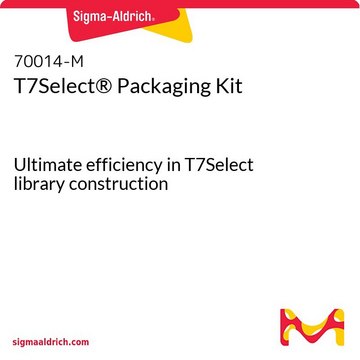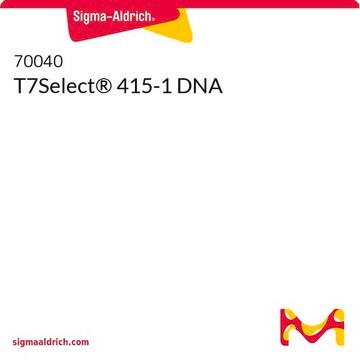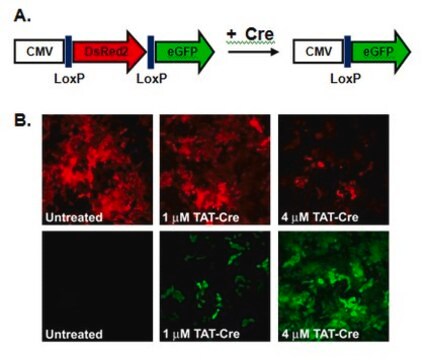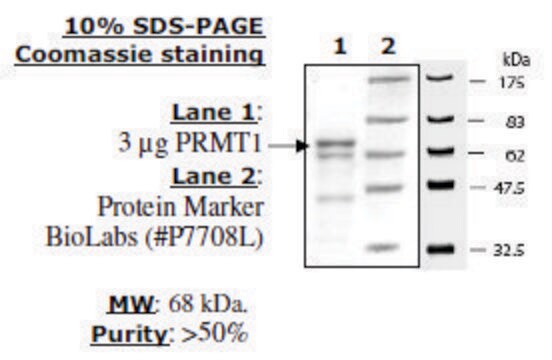70550-M
T7Select®10-3 Cloning Kit
Synonym(s):
Cloning kit, Novagen′s T7Select Phage Display System
Sign Into View Organizational & Contract Pricing
All Photos(1)
About This Item
UNSPSC Code:
41116133
NACRES:
NA.54
Recommended Products
manufacturer/tradename
Novagen®
Quality Level
storage condition
OK to freeze
avoid repeated freeze/thaw cycles
shipped in
dry ice
storage temp.
−70°C
General description
Novagen′s T7Select® Phage Display System is a novel phage display system that takes advantage of the properties of bacteriophage T7. This system is easy to use and has the capacity to display peptides up to about 50 amino acids in size in high copy number (415 per phage), and peptides or proteins up to about 1200 amino acids in low copy number (0.1-1 per phage) or mid-copy number (5-15 per phage). Phage assembly takes place in the E. coli cytoplasm and mature phage are released by cell lysis. Unlike the filamentous systems, peptides or proteins displayed on the surface of T7 do not need to be capable of secretion through the cell membrane, a necessary step in filamentous phage assembly.
T7 has additional properties that make it an attractive display vector. It is very easy to grow and replicates more rapidly than either bacteriophage l or filamentous phage. Plaques form within 3h at 37°C and cultures lyse 1-2 h after infection, decreasing the time needed to perform the multiple rounds of growth usually required for selection. The T7 phage particle is extremely robust, and is stable to harsh conditions that inactivate other phage. This stability expands the variety of agents that can be used in biopanning selection procedures, which require that the phage remain infective. T7 is an excellent general cloning vector. Purified DNA is easy to obtain in large amounts, a high-efficiency in vitro packaging system has been demonstrated (2), and the DNA is completely sequenced (39,937 bp), so restriction or DNA sequence analysis of clones is quite straightforward.
The T7Select Phage Display System uses the T7 capsid protein to display peptides or proteins on the surface of the phage. The capsid protein is normally made in two forms, 10A (344 aa) and 10B (397 aa). 10B is produced by a translational frameshift at amino acid 341 of 10A, and normally makes up about 10% of the capsid protein. However, functional capsids can be composed entirely of either 10A or 10B, or of various ratios of the proteins. This finding provided the initial suggestion that the T7 capsid shell could accommodate variation, and that the region of the capsid protein unique to 10B might be on the surface of the phage and could be used for phage display.There are 3 basic types of T7Select phage display vectors: the T7Select415 vector for high-copy number display of peptides, the T7Select10 vector for mid-copy number display of peptides or larger proteins, and the T7Select1 vectors for low-copy number display of peptides or larger proteins. In all of the vectors, coding sequences for the peptides or proteins to be displayed are cloned within a series of multiple cloning sites following aa 348 of the 10B protein. The natural translational frameshift site within the capsid gene has been removed, so only a single form of capsid protein is made from these vectors.
The T7Select System is sold for research use only. Any commercial use of this Product, including drug discovery or development of commercial products, requires a commercial license from EMD Millipore Corporation. Commercial use shall include but not be limited to (1) use of the Product or its components in manufacturing; (2) use of the Product or its components to provide a service, information, or data to others in exchange for consideration; (3) use of the Product or its components (or any derivatives thereof) for therapeutic, diagnostic or prophylactic purposes (including as part of a device, chip, assay or other product); or (4) resale of the Product or its components, whether or not such Product or its components are resold for use in research. Nothing contained herein shall be deemed to represent or warrant that additional third party rights are not required for use of this Product.
T7 has additional properties that make it an attractive display vector. It is very easy to grow and replicates more rapidly than either bacteriophage l or filamentous phage. Plaques form within 3h at 37°C and cultures lyse 1-2 h after infection, decreasing the time needed to perform the multiple rounds of growth usually required for selection. The T7 phage particle is extremely robust, and is stable to harsh conditions that inactivate other phage. This stability expands the variety of agents that can be used in biopanning selection procedures, which require that the phage remain infective. T7 is an excellent general cloning vector. Purified DNA is easy to obtain in large amounts, a high-efficiency in vitro packaging system has been demonstrated (2), and the DNA is completely sequenced (39,937 bp), so restriction or DNA sequence analysis of clones is quite straightforward.
The T7Select Phage Display System uses the T7 capsid protein to display peptides or proteins on the surface of the phage. The capsid protein is normally made in two forms, 10A (344 aa) and 10B (397 aa). 10B is produced by a translational frameshift at amino acid 341 of 10A, and normally makes up about 10% of the capsid protein. However, functional capsids can be composed entirely of either 10A or 10B, or of various ratios of the proteins. This finding provided the initial suggestion that the T7 capsid shell could accommodate variation, and that the region of the capsid protein unique to 10B might be on the surface of the phage and could be used for phage display.There are 3 basic types of T7Select phage display vectors: the T7Select415 vector for high-copy number display of peptides, the T7Select10 vector for mid-copy number display of peptides or larger proteins, and the T7Select1 vectors for low-copy number display of peptides or larger proteins. In all of the vectors, coding sequences for the peptides or proteins to be displayed are cloned within a series of multiple cloning sites following aa 348 of the 10B protein. The natural translational frameshift site within the capsid gene has been removed, so only a single form of capsid protein is made from these vectors.
The T7Select System is sold for research use only. Any commercial use of this Product, including drug discovery or development of commercial products, requires a commercial license from EMD Millipore Corporation. Commercial use shall include but not be limited to (1) use of the Product or its components in manufacturing; (2) use of the Product or its components to provide a service, information, or data to others in exchange for consideration; (3) use of the Product or its components (or any derivatives thereof) for therapeutic, diagnostic or prophylactic purposes (including as part of a device, chip, assay or other product); or (4) resale of the Product or its components, whether or not such Product or its components are resold for use in research. Nothing contained herein shall be deemed to represent or warrant that additional third party rights are not required for use of this Product.
Packaging
1 Kit in Glass Bottle
Components
- 5 µg -T7Select EcoR I/Hind III Vector Arms
- 0.2 pmol -T7Select Control Insert
- 6 -T7 Packaging Extracts
- 1 µg -T7Select Packaging Control DNA
- 0.2 ml- BLT5403, BLT5615, and BL21 glycerol stock
- 500 pmol- T7SelectUP primer
- 500 pmol- T7SelectDOWN primer
Warning
Toxicity: Standard Handling
Legal Information
NOVAGEN is a registered trademark of Merck KGaA, Darmstadt, Germany
T7SELECT is a registered trademark of Merck KGaA, Darmstadt, Germany
signalword
Danger
hcodes
Hazard Classifications
Acute Tox. 1 Oral
Storage Class
6.1A - Combustible acute toxic Cat. 1 and 2 / very toxic hazardous materials
wgk_germany
WGK 3
Certificates of Analysis (COA)
Search for Certificates of Analysis (COA) by entering the products Lot/Batch Number. Lot and Batch Numbers can be found on a product’s label following the words ‘Lot’ or ‘Batch’.
Already Own This Product?
Find documentation for the products that you have recently purchased in the Document Library.
Our team of scientists has experience in all areas of research including Life Science, Material Science, Chemical Synthesis, Chromatography, Analytical and many others.
Contact Technical Service









